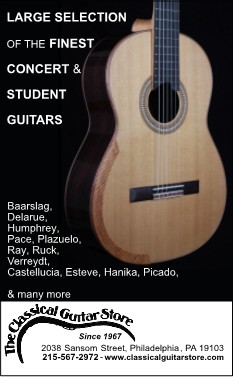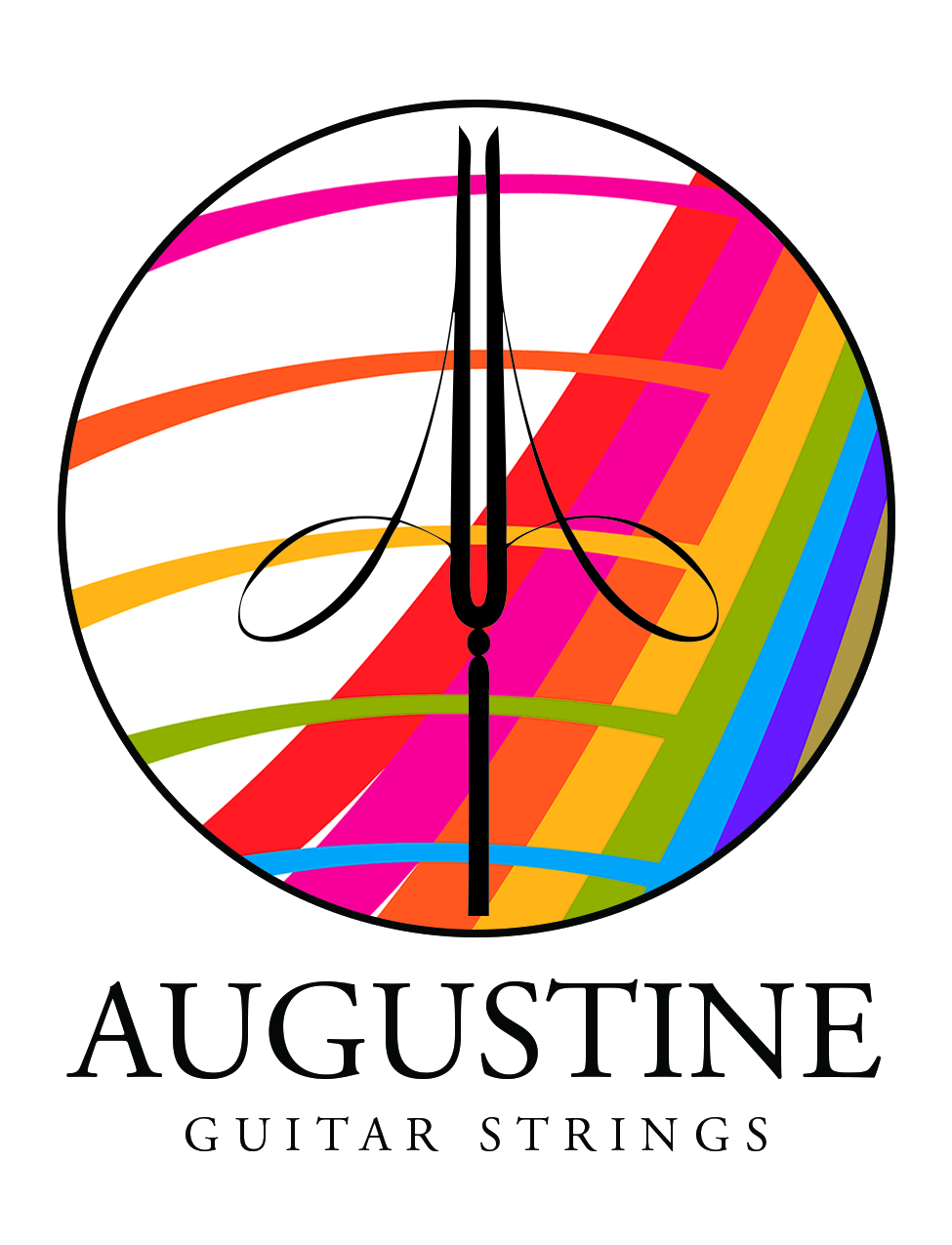By: Jordan T. Peterson, PCGS Professional Member
The repertoire for the classical guitar is limited compared to, say, the flute or the piano. This may be attributed to a variety of factors, namely the decline in popularity in the 19th century due to the invention and rise in popularity of the pianoforte. Quick rundown explaining this: the piano served composers as an orchestration tool, or a versatile utility. One can plunk out 10 notes at a time with all ten digits on both hands, as well as sound bass-y basses and falsetto-y falsettos. Both of the aforementioned combined can assist a composer in constructing a piece of music for multiple instruments and hear the parts played all at once (keyboard transcription), not having to resort to other, less savory means in order to listen to their product. The piano was the Turducken of instruments (could’ve used Swiss Army knife instead of turducken, but I stick by what I said!). The guitar is not as versatile in that regard. That combined with the piano being able to accompany voice, or any other instrument for that matter (something the early guitar was regularly used for), led to the decline in popularity of our 6-stringed friend. Hence, compositions for guitar came to a grinding halt and its popularity waned.
However…
Thanks to a renaissance led by Andres Segovia, the guitar recovered, barely escaping the fate of the glass harmonica and the hurdy-gurdy. With the prolonged dip in popularity, the guitar lost a lot of ground repertoire-wise. This is why guitarists and guitar enthusiasts alike not only keep the repertoire we do have close to their hearts, we defend it tooth and nail.
As a byproduct, when the lay-guitar performer/enthusiast considers the composers who contributed to that repertoire (whether they knew it or not… more on this later), they typically get labeled as “guitar composers.” More often than not, this labeling is completely inaccurate and passively dismissive of the rest of those composers’ oeuvre. So, let’s look at some numbers, and ponder what we can do and why it matters.
Data! Data everywhere!
We live in an age where we can easily aggregate data to prove what was once speculation. Case and point: An artist’s most popular pieces, thanks to Spotify keeping track of the number of times a piece was streamed. Before such accessible data, heated, if not almost fatal, arguments may have ensued over this issue–let’s put this baby to bed.
Before we start, how does Spotify count streams? “Song stream: Counted when someone listens for over 30 seconds” (from: https://artists.spotify.com/help/article/how-we-count-streams). Okay, let’s hit it.
Frederico Moreno Torroba:
Not a guitarist. Organist/keyboardist, in fact. He wrote operas, ballets, a slew of orchestral works. So what are his most popular pieces according to spotify?
- Suite Castellana. I. Fandango
Performer: Slava Grigoryan
Piece for Solo Guitar
Streams: 199,697
- Castillos de Espana II. Torija
Performer: Pablo Sainz
Piece for Solo Guitar
Streams: 170,321
- Romance de los Pinos
Performer: Andres Segovia
Piece for Solo Guitar
Streams: 465,520
- Suite Castellana: Danza
Performer: Enno Voorhorst
Piece for Solo Guitar
Streams: 81,646
- Castillos de Espana II: no. 3. Alcaniz
Performer: Ana Vidovic
Piece for Solo Guitar
Streams: 161,846
Granted, he, like some of the other composers on this list, had a close relationship with Andres Segovia and wrote several guitar pieces for him. However, that does not detract from the fact that all of the top popular pieces listed by Spotify are pieces for solo guitar.
Manuel M. Ponce:
Not a guitarist. Pianist. One of the most important and renowned composers in Mexico, with a focus on nationalistic/folk, as well as “learn-ed,” pieces/works. Composed several pieces/works for piano, orchestra, chamber ensembles, and voice…
- Por ti mi Corazon
Performer: Jason Vieaux
Piece for Voice and Piano, performed on Solo Guitar
Streams: 982,618
- Estrillita
Performer: Manuel Barrueco
Piece for Voice and Piano, performed on Solo Guitar
Streams: 758,746
- Serenata Mexicana
Performer: Luis Cobos
Piece for Voice and Piano, performed on Solo Harp
Streams: 414,842
- Estrillita
Performer: Timo Korhonen
Piece for Voice and Piano, performed on Solo Guitar
Streams: 485,325
- Estrillita
Performer: Lucio Degani and Andrea Rucli, Violin and Piano, respectively
Piece for Voice and Piano, performed on Violin and Piano
Streams: 233,410
Again, there is a Segovia connection. Not just that, Ponce was one of Segovia’s favorite composers. Ponce would go on to compose some of the most important works/pieces in the guitar repertoire, including full-scale sonatas and a concerto! Needless to say, his charmer of a song, Estrillita, is regarded as his most popular work.
Mario Castelnuovo-Tedesco:
Not a guitarist. It’s amazing, the output of this guy. Ballets, orchestral works, piano, choral and voice pieces, and so on and so on. Let’s look at the stats:
- Sonatina Canonica, Op. 196: II. Tempo di Siciliane
Performer: Brasil Guitar Duo
Piece for Two Guitars
Streams: 558,105
- Tarantella, Op. 87
Performer: Andres Segovia
Piece for Solo Guitar
Streams: 108,353
- Capricho Diabolico, Op. 85
Performer: Andres Segovia
Piece for Solo Guitar
Streams: 100,444
- Capriccio, Op. 195, No. 18 “El Sueno de la Razon Produce Monstruos”
Performer: Zoran Dukic
Piece for Solo Guitar
Streams: 32,061
- Greeting Cards: Tonadilla (on the name of Andres Segovia)
Performer: Andres Segovia
Piece for Solo Guitar
Streams: 56,759
All guitar.
Isaac Albeniz:
Not a guitarist. Never even wrote a single piece for or including guitar.
- Suite Espanola No. 1, Op. 47: No. 5, Asturias (Leyenda)
Performer: John Williams
Piece for Solo Piano performed on Guitar
Streams: 5,083,077
- Asturias (Leyenda) [Author’s note: This title is incorrect]
Performer: Simon Dinnigan
Piece for Solo Piano performed on Guitar
Streams: 2,473,728
- Malaguena
Performer: Laurent Korcia and Haruko Ueda
Piece for Violin and Piano
Streams: 740,816
- Suite Espanola No. 1, Op. 47: I. Granada – Serenata
Performer: Isabel Martinez
Piece for Solo Piano performed on Guitar
Streams: 530,802
- Espana, Op. 165: No. 2, Tango
Performer: Katrin Scholz and Gerald Fauth
Piece for Violin and Piano
Streams: 378,530
No surprise here, when we think of Albeniz’s music, we automatically think of that exhilarating piece that The Doors referenced in “Spanish Caravan”. So how are 3 out of the 5 most popular streams composed by Albeniz but not originally intended for guitar, so popular? The pieces lend themselves well to the guitar in several ways. To explain why they work on guitar so well, the pieces:
A: …are “effective” when transcribed. Some pieces do not transcribe well. They may have polar voicings that are impossible to achieve on the guitar. Perhaps several important voices that are integral to the piece that are, again, incapable of being achieved on the guitar (looking at you, Bach 7-voiced Credo BWV 232). Sometimes the parts need to be sounded for a long amount of time, like an organ piece (Messaien “L’Ascension”), and since notes sounded on guitar fade quickly, this would be impossible.
An effective transcription “fits in the hand,” so to speak, in that a guitarist can achieve (close-to) correct harmonies/counterpoint and a clear, recognizable melody.
B. ….sing. The pieces sing. While a piano, say, shines in the category of range of tones, the guitar is a master of tone. The piano paints in shades, whereas the guitar has an entire palette of color. It can evoke the sound of a voice, the timbre of an oboe, the smoothness of a viola, and the loftiness of a cello. Simply put, the guitar evokes tones and timbres that, arguably, other instruments cannot.
C. …were probably composed with the guitar in mind. I’ve argued before that compositions can be written for an instrumentation but the instrument the composer decides to put on the top of the score acts as a vehicle for the music. In this case, Albeniz (speculatively) used the piano as a vehicle for the Leyenda, and is said to have written the piece in the style of “Andalusian flamenco traditions.”
An honorable mention is Enrique Granados, who, like Albeniz, never composed a piece for the guitar, but is regarded for his pieces that were transcribed for the guitar.
Outputs:
Only one main output here: listen to other pieces by the composer. We live in an age where a person can leave a streaming service play every second of their life, from the cradle to the grave, and not a single song/piece would repeat. Moreover, we can listen to an artist’s entire oeuvre without having to travel to a venue or buy anything (hire an artist, buy tickets or albums, etc.).
The classics are classics for a reason, but chances are: if you like one piece from a composer, you’ll probably like others that they wrote.
There are added benefits to listening to a composer’s other works.
- A more intimate relationship with them. You learn what types of pieces they like to compose, e.g. folks songs, dances, orchestral works, chamber works, etc. You often hear the songs they grew up with in their time, or that were popular in their sphere of influence. You can also glean their stylistic periods (Brouwer is a great roadmap of the styles of the 21st century, and Liszt, the transition from romantic to post-tonal).
- You learn their language. As you listen to more and more of a certain composer’s oeuvre, you pick up on their patterns and compositional decisions, and even psyche/pathos. What their tendencies are, and their harmonic or rhythmic biases. Sometimes you can gather what they are uncomfortable writing (check out Beethoven’s years-long tussle with Fidelio/Leonore and opera in general).
- You broaden your horizons. You will learn about types of music you never knew about. You will most definitely find new pieces to fall in love with by that composer. You can also find pieces you could, yourself, transcribe for guitar.
With Spotify’s algorithms, you will also find new artists and composers you never knew about!
Another suggestion: listen to the same piece by different performers. You can gain invaluable insights about how differing tempos make the composition evoke a totally different spirit (Villa Lobos “12 Etudes”) or how the performer takes liberties (Perroy’s smooth transitioning from one variation to the next in Ponce’s “Folia variations”, as opposed to each variation being isolated from one another).
In short, never be satisfied, use the tech and tools available to you, and you will become a better listener and musician!






Comments are closed.